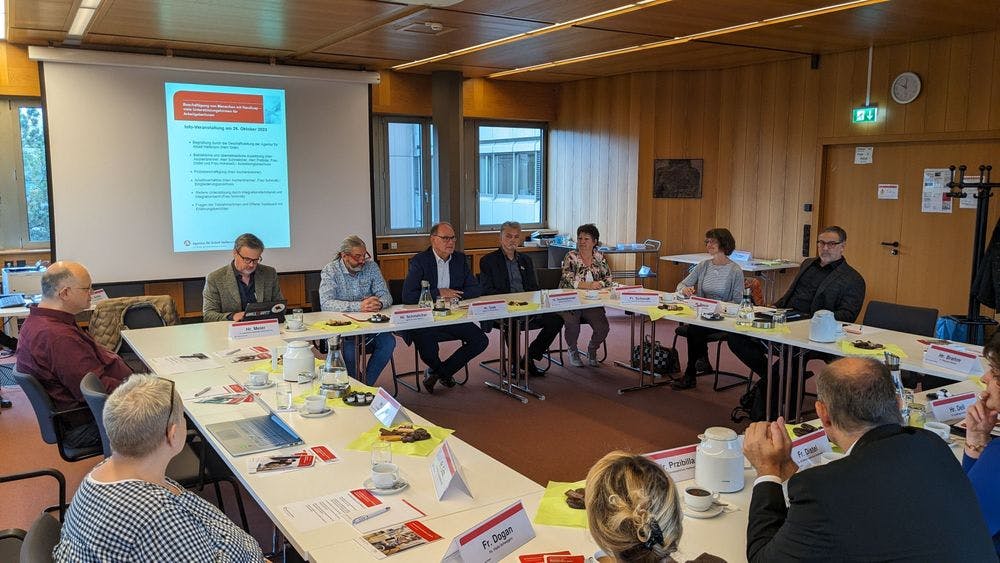
Inclusion as Opportunity: How People with Disabilities Enrich the IT Industry
On October 26, 2023, I had the honor of representing connect.IT at an informative event organized by the Federal Employment Agency in Heilbronn, dedicated to a topic of increasing importance in the IT industry: the integration of people with disabilities into the workforce. In an era where diversity and inclusion are recognized not just as social imperatives but also as keys to creative and innovative teams, this event provided deep insights into employment opportunities for people with disabilities and the various support options available for companies wishing to engage in this important area.
Falk Aschenbrenner, a rehabilitation/special needs specialist at the Federal Employment Agency in Heilbronn, initiated a dialogue on the challenges and opportunities presented by the integration of people with disabilities. The event served not only as a platform for information but also as a place for exchange between employers, educational and integration services, and advisory institutions.
Manfred Grab, managing director of the Federal Employment Agency in Heilbronn, shared his enriching experiences from the nationwide "Shift Change" event, where people with and without disabilities swap jobs for a day. This gave him the opportunity to work in the metal workshop of a therapeutic center, allowing him to firsthand experience the importance and value of such facilities.
The event presented various models of vocational integration and training, which create flexible and supportive conditions to meet the individual needs and abilities of people with disabilities.
In the training sector, the following models were discussed:
Company training with funding opportunities:
- Goal: Qualification of people with disabilities directly within the company.
- Support: Financial grants for training remuneration and workplace adaptation.
Rehabilitation training (Cooperative Vocational Training)
- Structure: Partnership between educational institutions and companies.
- Procedure: Combination of vocational school, specialized support teaching, and practical work in the company.
- Costs: No direct training costs for the company.
Training in vocational training centers:
- Target group: Young people with special support needs.
- Environment: Theoretical and practical training in specialized facilities.
- Cooperation: Internships and parts of the training in cooperative companies.
- Costs: No direct training costs for the company.
Stefan Przibilla, department head of International Bund (IB) in Heilbronn, provided an insightful overview of the rehabilitation training process, designed as cooperative vocational training for people with special support needs. The typical structure of this training consists of one day of vocational school, one day at IB with support and enhancement classes and social pedagogical care, followed by three days of practical work in a cooperative company. Despite the current low demand in the IT sector, Przibilla emphasized the openness and willingness to advise and support companies in this area, to expand the chances and opportunities for rehabilitation training in the IT industry.
Elke Hoheisel from the Vocational Training Center Mosbach Heidelberg presented the opportunities available for young people with special support needs in recognized training professions. At the Vocational Training Center, a combination of school education and practical application is offered, for example, in workshops. Hoheisel emphasized the Vocational Training Center's strong interest in cooperating with companies, which can be realized through internships or a combined training program, where parts of the training take place directly in the company – here, too, there are no costs for the companies. Especially in the field of IT, there has already been success with eight graduates, highlighting the growing importance of IT in this sector. Additionally, it was highlighted that such training programs can also offer a valuable perspective for adult individuals.
Mr. Aschenbrenner discussed the flexibility and necessity of individual solutions in the field of company training. He stressed that due to the variety of disabilities, there can be no "one-size-fits-all solution" and that special requirements must be taken into account. The range of training subsidies usually varies between 30-60%, with provisions also possible for exceptional cases.
A central theme was the integration following training and the associated concerns of employers. A solution approach is the trial employment contract, which can run up to three months without any contractual obligations, during which wages are reimbursed at 100% regardless of whether the employment is permanent or not. This model applies both after training and to applicants and can also enable support during subsequent employment.
The overarching goal is the long-term and sustainable integration of people with disabilities into the labor market.
Elke Schmidt from the Integration Service introduced the work of the Uniform Contact Points for Employers (EAA) and highlighted the wide spectrum of disabilities they encounter in their work. She pointed out that disabilities can be both visible and invisible, ranging from physical limitations like spinal problems to mental illnesses like depression, as well as sensory impairments and autism. Schmidt emphasized the importance of individual workplace adjustments and explained that the Integration Service also offers support for the disability-appropriate equipment of workplaces to ensure optimal integration and productivity.
For companies embarking on the path of inclusion, the Employment Agency or the Uniform Contact Points for Employers (EAA) often serve as the first point of contact. Once the responsible cost carrier – whether it's the Federal Employment Agency, pension insurance, or professional association – is identified, detailed advice on further options is provided.
For IT companies looking for qualified personnel, employing people with disabilities can present a enriching opportunity. This group often brings a high level of motivation and gratitude for the opportunities provided, leading to increased willingness to perform. Moreover, diversity within the team can not only contribute to a positive work atmosphere but also lead to innovative solutions and an expanded understanding of different user perspectives.
The event concluded with a clear call to the social responsibility and economic wisdom of companies to perceive diversity as an opportunity. Employers who cater to the special needs of people with disabilities can not only benefit from their exceptional motivation and loyalty but also enrich their teams with unique perspectives. The integration into the labor market goes beyond mere job placement; it is a step towards a more inclusive society and a more dynamic, creative work environment.
In the IT industry, where innovative thinking and problem-solving abilities are crucial, tapping into the potential of people with disabilities can offer an invaluable advantage.


